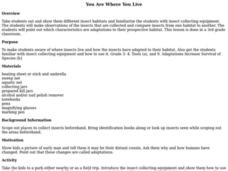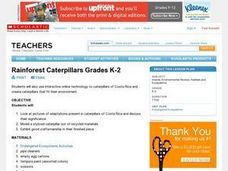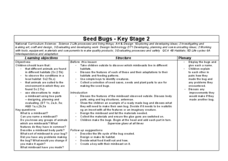Global Change
Impact of Climate Change on the Desert Pupfish
A fish that lives in the desert? You and your class can meet the desert pupfish as they examine its habitat, the role humans play in diminishing water supplies, and how climate change might impact this fishy friend. There are four short...
Howard Hughes Medical Institute
Seed Dispersal in Tropical Forests
How do seeds get around? It's not like plants can control seed dispersal—or can they? Dig deeper into the amazing mechanisms of seed dispersal observed in tropical plants through interactives, a video, and plenty of hands-on data...
Curated OER
You Are Where You Live
Third graders observe insects in a number of habitats. They recognize which insect characteristics are adaptations to their habitats.
Curated OER
Aquatic Insects: Water Quality Index & Diversity Index
Students search stream beds to study the life cycle and adaptations of stream insects. They explore creeks and streams to see the diversity index of creeks or streams and to find the water qualit index.
Curated OER
The Evolution of Canis pedatus
Students examine the given characteristics of a previously unknown dog-like creature, Canis pedatus, to decide if the creatures would survive when relocated to a new environment. They work in small groups to decide whether or not the...
Curated OER
Rainforest Caterpillars Grades K-2
Students are told that after they discuss and examine of rainforest caterpillars, they are going to create their own rainforest caterpillar based on the information they have studied. They are given the habitat scenarios on 3x5 cards.
Curated OER
The Sensitive Scavenger
Students create multi-sensory scavenger hunt worksheet to be used on a scavenger hunt throughout the schoolyard habitat area to introduce students to concepts of biodiversity and interdependence within a habitat.
Curated OER
Seed Bugs; Stage 2
Learners examine nature by participating in an environmental art activity. For this imaginary creature lesson, students discuss the importance of a habitat when pertaining to wild animals or bugs. Learners utilize tree parts which they...
Curated OER
Fun With Fish Forms
Students explore fish adaptations and anatomy. In this science lesson, students discuss various adaptations of fish and how those adaptations help them.
Curated OER
What Does it Take to be a Survivor: Part 2
Students explore adaptation by completing worksheets. In this fish anatomy lesson, students identify the different survival strategies fish utilize to live in the ocean and the adaptation their bodies have gone through over millions of...
Curated OER
The Trouble with Crayfish
Fourth graders compare an ecosystem before and after they introduce crayfish to that ecosystem. In this ecosystem lesson plan, 4th graders see what happens when you introduce a non native animal to a habitat. Students then make...
Curated OER
Easy as Pi
Students describe the importance of structural features that increase surface area in a coral reef habitat. In this investigative activity students quantify the impact of modifications on surface area in model habitats.
Curated OER
The Insect Files
Students are provided with a physical description of the insect, in words and graphics, including body parts, special adaptations, color, and so on. They explore and report on all four elements of an insect's habitat: food, water,...
Curated OER
Science: Why Animals Hibernate
Second graders investigate the reasons animals hibernate. They measure their own heart rates and compare them to those of a hibernating bear. In their journals, 2nd graders record facts about and characteristics of hibernation and...
Curated OER
Habitats
Learners examine how different living things interact with their environment. As a class, they discuss the characteristics of a habitat and write the list on the board. In groups, they focus on one habitat and create a mural of the...
Curated OER
Nowhere to Hide
Students examine the topic of natural selection. As a class, they write their own definition to survival of the fittest and watch a video. Using the internet, they research how Darwin started to examine this process using finches and how...
Curated OER
Dissolved Oxygen and Temperature
Students are shown how temperature affects dissolved oxygen and they create a graph showing this relationship. They think about the adaptations of animals to live in different water temperatures. Students test four different water...
Curated OER
The Wonderful World of Slugs
Examine a slug? Of course, what else would a 2nd grader do with it? Pupils use clues and go on a slug hunt, read a slug story, or make a cooperative group mural of a slug's habitat. While older learners catalog slugs, go on a slug hunt,...
Curated OER
Nest Watch
Pupils describe the nests of three common birds. They build a specific type of bird nest, using the same materials a bird would use. Students build a nest platform to attract a nesting pair of osprey. They observe, record, and submit...
Curated OER
Natural Selection: Exploring the 'Ohi'a Common Garden
Seventh graders examine natural variation by visiting the Ohi'a Common Garden in Volcano, Hawaii. In this natural selection lesson, 7th graders study background information about phenotypes, genotypes, and phenotypic plasticity before...
Curated OER
Physical Adaptations in Ice Age Mammals
Learners identify the body parts in Ice Age mammals that allowed them to survive. They answer questions as a class and discuss. They examine photographs of the animals as well.
Montana State University
Everest Extremes: Biodiversity
How many animals can live in a climate as cold as Mount Everest's? Find out with a science lesson all about biodiversity. Activities include research, presentations, group work, coloring maps, and a simulation of a food web.
Curated OER
Exploring the Uses of Beaks
Students explore the uses of bird beaks in the wild by participating in experiment stations. In this bird adaptation lesson, students work in groups and complete experiment stations that represent different types of bird beaks. Students...
Curated OER
Native Plant Restoration Project
Students distinguish between exotic and native plant species. They work in groups in the field to restore a natural habitat. A class map is created to reflect their work in the field.
Other popular searches
- Animal Habitats Adaptation
- Animal Adaptation Habitat
- Penguins Adaptation Habitat
- Penguin Adaptation Habitat
- Bird Habitat and Adaptation
- Habitat and Adaptation

























